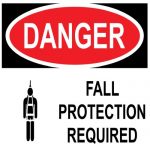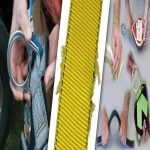Lifetime of Fall Arrest Equipment
 How many times have you gotten the question “When do I need to replace my harness”? The first thing you would do is look to ANSI Standards or OSHA Regulations for an answer. Coincidentally, they leave it up to the manufacturer to determine how long a harness or lanyard should be left in service.
How many times have you gotten the question “When do I need to replace my harness”? The first thing you would do is look to ANSI Standards or OSHA Regulations for an answer. Coincidentally, they leave it up to the manufacturer to determine how long a harness or lanyard should be left in service.
ANSI Equipment Inspection Requirements
If you read ANSI Z359.1 section 6.1 states Inspection:
“Equipment shall be inspected by the user before each use and additionally, by a competent person other than the user at intervals of no more than one year.”
Further description by ANSI as referenced in Explanatory Information E6.1.1 is as follows;
“The purpose of two-level inspection of equipment is to provide two independent means for guarding against oversight in the detecting and controlling against the use of defective, damaged and improperly maintained equipment. If such equipment conditions are observed by the competent person’s inspection, measures should be taken to provide the user with additional training or retraining in equipment inspection, maintenance, use, and storage. Such observations may also suggest the need for selection of alternative equipment more suitable for the conditions of use. The frequency of periodic inspection by a competent person should be established by the user’s organization based upon careful consideration of relevant factors. Such factors include the nature and severity of workplace conditions affecting the equipment and the modes of use and exposure time of equipment.”
Easy to interpret, right? The best way to approach this and implement into your own program is to look at each manufacturer’s guidelines and follow those rules specific to that equipment.
 Fall Protection Manufacturers Inspection Guidelines
Fall Protection Manufacturers Inspection Guidelines
Here are a few examples:
MILLER:
ANSI A10.32-2012, which replaced A10.32.2004, does not reference a 5-year service life for synthetic fiber products. The standard states that fall protection equipment shall be removed from service upon evidence of defects, damage or deterioration; once it has been subjected to impact loading; or upon expiration of the manufacturer’s specified service life, whichever comes first. Miller Fall Protection previously acknowledged the ANSI A10.32.2004 standard and the five-year life as a general guideline that was not to be used in lieu of the inspection and maintenance criteria outlined in the instructions that accompany each unit.
DBI-SALA:
The current DBI-SALA policy on the life of products is totally dependent on the condition of the item and not the age. A DBI-SALA product can be used as long as the inspection performed does not reveal any damage, wear, or other characteristics that will affect the product’s performance. The inspection of the product shall be performed according to details outlined in the user instruction manual on the specific product as well as other applicable information provided by DBI-SALA.
FALL TECH:
While there is no set “life-expectancy” for a harness, lanyard or any fall protection equipment, following the above guidelines will help determine how long your equipment should remain in service. Equipment that is used 8 hours a day, 5 days a week will not have the life expectancy of equipment used not so often. Careful observation is key when inspecting your equipment. Check the webbing, stitching, labels, and hardware for signs of deterioration. If deterioration is evident, discard the equipment. If not, return the equipment to service.
GUARDIAN:
ANSI and OSHA maintain that it is up to the manufacturer to set the shelf life (“life expectancy”) fir their products. For Guardian Fall Protection, the shelf life is five (5) years from the date of first use. Again, the key here is to follow inspection rules of ANSI, OSHA and Guardian.
As you can see, inspection of the equipment is a key component to your program and distinguishing if the equipment is suitable for use. This was discussed in our previous blog on Fall Protection Programs and their importance.

